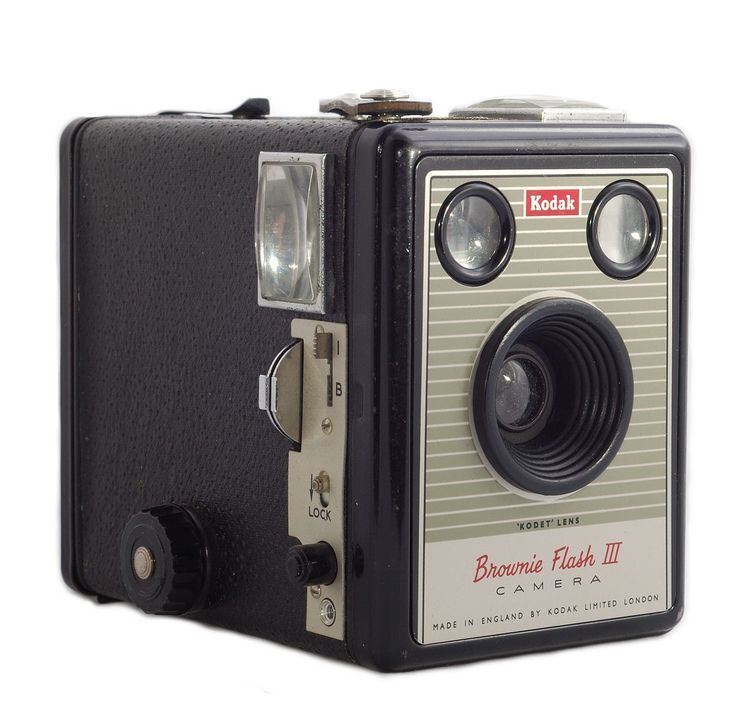 | ||
Brownie is the name of a long-running popular series of simple and inexpensive cameras made by Eastman Kodak.
Contents
- Overview
- Brownie Number 2
- Beau Brownie
- Some Brownie camera models
- Photographs taken with Brownie cameras
- References
The Brownie camera, introduced in February 1900, invented low-cost photography by introducing the concept of the snapshot to the masses. The Brownie, was a very basic cardboard box camera with a simple meniscus lens that took 2 1/4-inch square pictures on 117 roll film. The Brownie camera was conceived and marketed for sales of Kodak roll films. Because of its simple controls and initial price of $1 along with the low price of Kodak roll film and processing, The Brownie camera achieved and surpassed its marketing goal.
The Brownie is among the most important cameras in history.
Overview
The first model of the camera was invented by Frank A. Brownell. The name comes from the brownies in popular Palmer Cox cartoons. Consumers responded, and over 150,000 Brownie cameras were shipped in the first year of production. An improved model, called No. 2 Brownie came in 1901, which produced larger 2-1/4 by 3-1/4 inch photos and cost $2. It was also very popular.
In 1908, the Austrian architectural critic Joseph August Lux wrote a book called Künstlerische Kodakgeheimnisse (Artistic Secrets of the Kodak) in which he championed the use of the camera for its cultural potential. Guided by a position that was influenced by the Catholic critique of modernity, he argued that the accessibility the camera provided for the amateur meant that people could photograph and document their surroundings and thus produce a type of stability in the ebb and flow of the modern world.
Brownies were extensively marketed to children, with Kodak using them to popularise photography. They were also taken to war by soldiers. As they were so ubiquitous, many iconic shots were taken on brownies.
The cameras continued to be popular, and spawned many varieties, such as a Boy Scout edition in the 1930s. Improvements continued, such as in 1940, when Kodak released the Six-20 Flash Brownie. The camera was Kodak's first internally synchronized flash camera, using General electric bulbs. Then in 1957, Kodak produced the Brownie Starflash, Kodak's first camera with a built in flash.
One of the most popular Brownie models was the Brownie 127, millions of which were sold between 1952 and 1967. The Brownie 127 was a simple bakelite camera for 127 film which featured a simple meniscus lens and a curved film plane to compensate for the deficiencies of the lens. Another simple camera was the Brownie Cresta which was sold between 1955 and 1958. It used 120 film and had a fixed-focus lens.
Having written an article in the 1940s for amateur photographers suggesting an expensive camera was unnecessary for quality photography, Picture Post photographer Bert Hardy used a Brownie camera to stage a carefully posed snapshot of two young women sitting on railings above a breezy Blackpool promenade.
The last official Brownie cameras made were "anniversary model", 110 film models in the early 1980s.
Brownie Number 2
The Kodak Brownie Number 2 is a box camera that was manufactured by the Eastman Kodak Company from 1901 to 1935. There were five models, A through F, and it was the first camera to use 120 film. It also came with a viewfinder and a handle. The Brownie Number 2 was made of three materials; cardboard, costing US$2.00, aluminum, costing US$2.75, and a color model which cost US$2.50. It was a very popular and affordable camera, and many are still in use by film photographers .
Beau Brownie
The Beau Brownie range was available from 1930 to 1933.
They differed little from the popular Brownie cameras, the only technical difference being the introduction of a new doublet lens, allowing the same picture to be projected on a film plate over a shorter distance, making the Beau Brownies nearly 2" shorter than their conventional counterparts.
Visually, they had a different enameled two-tone front plate in a geometric Art Deco design, the work of American designer Walter Dorwin Teague.
They were available in five color combinations: black and burgundy, brown and tan, two-tone blue, two-tone green, and two-tone rose. The rose and green cameras were produced only in 1930 and 1931, and are therefore rarer than the others. They were encased in a faux-leatherette casing.
There were two formats, the $4 No.2 and $5 2A, just like the Brownies, the No.2 measuring 2 ¼" by 3 ¼" and using 120 roll film, and the 2A measuring 2½" by 4¼", and taking 116 Kodak roll film. The 2A had a thicker, bakelite rim and was an inch taller than the No. 2.
